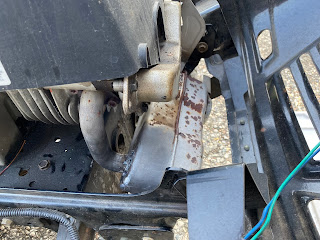When springtime comes a not so young man's thoughts turn to lawn care.
And so this weekend I hauled my old lawn tractor out from its winter hibernation. After giving the battery a quick charge and adding some fresh gas to the tank, I started the old girl up for the first time this year.
I've had this tractor for about 10 years and it always provided faithful service in keeping the grass around the house nice and trimmed.
So I was a bit bummed out when, after starting the engine I was greeted with a metallic clang and a really loud noise coming from the engine,.
Hopping off the tractor, I immediately found the cause. On the ground, in front of the tractor, I found a large metal box - more commonly referred to as a muffler.
On the tractor itself, where the muffler used to be was now a length of straight pipe coming out of the exhaust manifold of the engine.
Now in certain circles, I know some people would consider having a straight pipe for an exhaust system as the summit of cool, but considering that this was a lawnmower that will be circling around my property for an hour or 2 each week, I don't think my neighbors will think it very cool to run without a muffler.
Running to the computer I did a quick search for what a new replacement muffler would run me. I was a bit shocked. at what I found.
A new OEM muffler was going to cost me over $100 once I factored in the shipping costs. To add further insult to injury, the muffler was also on backorder so it would be a while before I got it if I did order it. The fact that it was on backorder also told me that this was a fairly common wear item for my tractor.
I was not very keen on shelling out $100 for what was basically a metal box. Secondly, I had visions of the muffler arriving in the fall, after a season of me slowly going deaf from cutting the grass.
Trying to figure out my options, I took a closer look at the muffler parts.
Once the torch was going, I slowly turned on the oxygen until I got a nice Neutral flame on the end of the torch
Next, I heated the seam of the pipe and muffler with the torch until the metal glowed red and I then filled in the seam with a copper brazing rod. I keep going around the seam with the torch and rod until I could no longer see any gaps in the seam.Once the muffler cooled down, the final step was to reinstall the muffler back on the tractor by reattaching the straight pipe back onto the exhaust manifold of the tractor, making sure to have the gasket installed between the engine and the pipe and making the bolts as tight as possible.
When I started the tractor again, things were a lot more quieter. Over the course of the season, I will be keeping an eye on the muffler.
Since this is definitely a known failure point, there is a potential that I may need to do a mid-season patch up (though I hope not!), however as I have found out, it's a pretty quick fix.



















No comments:
Post a Comment